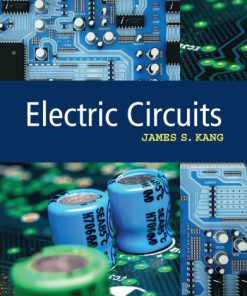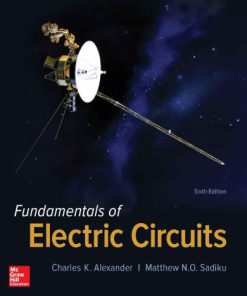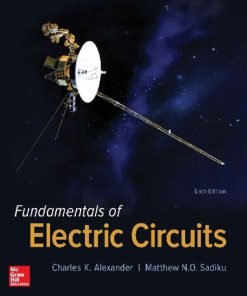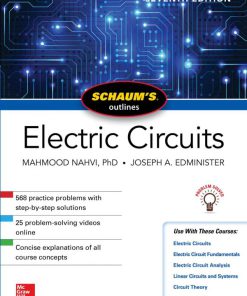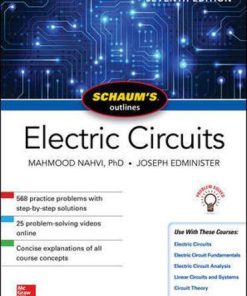Introduction to Electric Circuits 9th Edition by James Svoboda, Richard Dorf ISBN 9781118560600 1118560604
$50.00 Original price was: $50.00.$25.00Current price is: $25.00.
Introduction to Electric Circuits 9th Edition by James Svoboda, Richard Dorf – Ebook PDF Instant Download/Delivery: 9781118560600 ,1118560604
Full download Introduction to Electric Circuits 9th Edition after payment
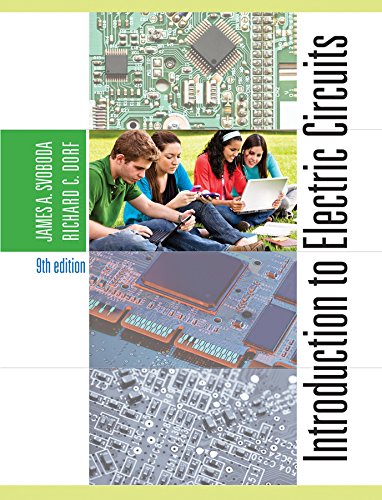
Product details:
ISBN 10: 1118560604
ISBN 13: 9781118560600
Author: James Svoboda, Richard Dorf
Introduction to Electric Circuits 9th Edition Table of contents:
CHAPTER 1 Electric Circuit Variables
1.1 Introduction
1.2 Electric Circuits and Current
1.3 Systems of Units
1.4 Voltage
1.5 Power and Energy
1.6 Circuit Analysis and Design
1.7 How Can We Check . . . ?
1.8 Design Example—Jet Valve Controller
1.9 Summary
Problems
Design Problems
CHAPTER 2 Circuit Elements
2.1 Introduction
2.2 Engineering and Linear Models
2.3 Active and Passive Circuit Elements
2.4 Resistors
2.5 Independent Sources
2.6 Voltmeters and Ammeters
2.7 Dependent Sources
2.8 Transducers
2.9 Switches
2.10 How Can We Check . . . ?
2.11 Design Example—Temperature Sensor
2.12 Summary
Problems
Design Problems
CHAPTER 3 Resistive Circuits
3.1 Introduction
3.2 Kirchhoff’s Laws
3.3 Series Resistors and Voltage Division
3.4 Parallel Resistors and Current Division
3.5 Series Voltage Sources and Parallel Current Sources
3.6 Circuit Analysis
3.7 Analyzing Resistive Circuits Using MATLAB
3.8 How Can We Check . . . ?
3.9 Design Example—Adjustable Voltage Source
3.10 Summary
Problems
Design Problems
CHAPTER 4 Methods of Analysis of Resistive Circuits
4.1 Introduction
4.2 Node Voltage Analysis of Circuits with Current Sources
4.3 Node Voltage Analysis of Circuits with Current and Voltage Sources
4.4 Node Voltage Analysis with Dependent Sources
4.5 Mesh Current Analysis with Independent Voltage Sources
4.6 Mesh Current Analysis with Current and Voltage Sources
4.7 Mesh Current Analysis with Dependent Sources
4.8 The Node Voltage Method and Mesh Current Method Compared
4.9 Circuit Analysis Using MATLAB
4.10 Using PSpice to Determine Node Voltages and Mesh Currents
4.11 How Can We Check . . . ?
4.12 Design Example—Potentiometer Angle Display
4.13 Summary
Problems
PSpice Problems
Design Problems
CHAPTER 5 Circuit Theorems
5.1 Introduction
5.2 Source Transformations
5.3 Superposition
5.4 Thévenin’s Theorem
5.5 Norton’s Equivalent Circuit
5.6 Maximum Power Transfer
5.7 Using MATLAB to Determine the Thévenin Equivalent Circuit
5.8 Using PSpice to Determine the Thévenin Equivalent Circuit
5.9 How Can We Check . . . ?
5.10 Design Example—Strain Gauge Bridge
5.11 Summary
Problems
PSpice Problems
Design Problems
CHAPTER 6 The Operational Amplifier
6.1 Introduction
6.2 The Operational Amplifier
6.3 The Ideal Operational Amplifier
6.4 Nodal Analysis of Circuits Containing Ideal Operational Amplifiers
6.5 Design Using Operational Amplifiers
6.6 Operational Amplifier Circuits and Linear Algebraic Equations
6.7 Characteristics of Practical Operational Amplifiers
6.8 Analysis of Op Amp Circuits Using MATLAB
6.9 Using PSpice to Analyze Op Amp Circuits
6.10 How Can We Check . . . ?
6.11 Design Example—Transducer Interface Circuit
6.12 Summary
Problems
PSpice Problems
Design Problems
CHAPTER 7 Energy Storage Elements
7.1 Introduction
7.2 Capacitors
7.3 Energy Storage in a Capacitor
7.4 Series and Parallel Capacitors
7.5 Inductors
7.6 Energy Storage in an Inductor
7.7 Series and Parallel Inductors
7.8 Initial Conditions of Switched Circuits
7.9 Operational Amplifier Circuits and Linear Differential Equations
7.10 Using MATLAB to Plot Capacitor or Inductor Voltage and Current
7.11 How Can We Check . . . ?
7.12 Design Example—Integrator and Switch
7.13 Summary
Problems
Design Problems
CHAPTER 8 The Complete Response of RL and RC Circuits
8.1 Introduction
8.2 First-Order Circuits
8.3 The Response of a First-Order Circuit to a Constant Input
8.4 Sequential Switching
8.5 Stability of First-Order Circuits
8.6 The Unit Step Source
8.7 The Response of a First-Order Circuit to a Nonconstant Source
8.8 Differential Operators
8.9 Using PSpice to Analyze First-Order Circuits
8.10 How Can We Check . . . ?
8.11 Design Example—A Computer and Printer
8.12 Summary
Problems
PSpice Problems
Design Problems
CHAPTER 9 The Complete Response of Circuits with Two Energy Storage Elements
9.1 Introduction
9.2 Differential Equation for Circuits with Two Energy Storage Elements
9.3 Solution of the Second-Order Differential Equation—The Natural Response
9.4 Natural Response of the Unforced Parallel RLC Circuit
9.5 Natural Response of the Critically Damped Unforced Parallel RLC Circuit
9.6 Natural Response of an Underdamped Unforced Parallel RLC Circuit
9.7 Forced Response of an RLC Circuit
9.8 Complete Response of an RLC Circuit
9.9 State Variable Approach to Circuit Analysis
9.10 Roots in the Complex Plane
9.11 How Can We Check . . . ?
9.12 Design Example—Auto Airbag Igniter
9.13 Summary
Problems
PSpice Problems
Design Problems
CHAPTER 10 Sinusoidal Steady-State Analysis
10.1 Introduction
10.2 Sinusoidal Sources
10.3 Phasors and Sinusoids
10.4 Impedances
10.5 Series and Parallel Impedances
10.6 Mesh and Node Equations
10.7 Thévenin and Norton Equivalent Circuits
10.8 Superposition
10.9 Phasor Diagrams
10.10 Op Amps in AC Circuits
10.11 The Complete Response
10.12 Using MATLAB to Analyze AC Circuits
10.13 Using PSpice to Analyze AC Circuits
10.14 How Can We Check . . . ?
10.15 Design Example—An Op Amp Circuit
10.16 Summary
Problems
PSpice Problems
Design Problems
CHAPTER 11 AC Steady-State Power
11.1 Introduction
11.2 Electric Power
11.3 Instantaneous Power and Average Power
11.4 Effective Value of a Periodic Waveform
11.5 Complex Power
11.6 Power Factor
11.7 The Power Superposition Principle
11.8 The Maximum Power Transfer Theorem
11.9 Coupled Inductors
11.10 The Ideal Transformer
11.11 How Can We Check . . . ?
11.12 Design Example—Maximum Power Transfer
11.13 Summary
Problems
PSpice Problems
Design Problems
CHAPTER 12 Three-Phase Circuits
12.1 Introduction
12.2 Three-Phase Voltages
12.3 The Y-to-Y Circuit
12.4 The Delta-Connected Source and Load
12.5 The Y-to-Delta Circuit
12.6 Balanced Three-Phase Circuits
12.7 Instantaneous and Average Power in a Balanced Three-Phase Load
12.8 Two-Wattmeter Power Measurement
12.9 How Can We Check . . . ?
12.10 Design Example—Power Factor Correction
12.11 Summary
Problems
PSpice Problems
Design Problems
CHAPTER 13 Frequency Response
13.1 Introduction
13.2 Gain, Phase Shift, and the Network Function
13.3 Bode Plots
13.4 Resonant Circuits
13.5 Frequency Response of Op Amp Circuits
13.6 Plotting Bode Plots Using MATLAB
13.7 Using PSpice to Plot a Frequency Response
13.8 How Can We Check . . . ?
13.9 Design Example—Radio Tuner
13.10 Summary
Problems
PSpice Problems
Design Problems
CHAPTER 14 The Laplace Transform
14.1 Introduction
14.2 Laplace Transform
14.3 Pulse Inputs
14.4 Inverse Laplace Transform
14.5 Initial and Final Value Theorems
14.6 Solution of Differential Equations Describing a Circuit
14.7 Circuit Analysis Using Impedance and Initial Conditions
14.8 Transfer Function and Impedance
14.9 Convolution
14.10 Stability
14.11 Partial Fraction Expansion Using MATLAB
14.12 How Can We Check . . . ?
14.13 Design Example—Space Shuttle Cargo Door
14.14 Summary
Problems
PSpice Problems
Design Problems
CHAPTER 15 Fourier Series and Fourier Transform
15.1 Introduction
15.2 The Fourier Series
15.3 Symmetry of the Function f (t)
15.4 Fourier Series of Selected Waveforms
15.5 Exponential Form of the Fourier Series
15.6 The Fourier Spectrum
15.7 Circuits and Fourier Series
15.8 Using PSpice to Determine the Fourier Series
15.9 The Fourier Transform
15.10 Fourier Transform Properties
15.11 The Spectrum of Signals
15.12 Convolution and Circuit Response
15.13 The Fourier Transform and the Laplace Transform
15.14 How Can We Check . . . ?
15.15 Design Example—DC Power Supply
15.16 Summary
Problems
PSpice Problems
Design Problems
CHAPTER 16 Filter Circuits
16.1 Introduction
16.2 The Electric Filter
16.3 Filters
16.4 Second-Order Filters
16.5 High-Order Filters
16.6 Simulating Filter Circuits Using PSpice
16.7 How Can We Check . . . ?
16.8 Design Example—Anti-Aliasing Filter
16.9 Summary
Problems
PSpice Problems
Design Problems
CHAPTER 17 Two-Port and Three-Port Networks
17.1 Introduction
17.2 T-to-Π Transformation and Two-Port Three-Terminal Networks
17.3 Equations of Two-Port Networks
17.4 Z and Y Parameters for a Circuit with Dependent Sources
17.5 Hybrid and Transmission Parameters
17.6 Relationships Between Two-Port Parameters
17.7 Interconnection of Two-Port Networks
17.8 How Can We Check . . . ?
17.9 Design Example—Transistor Amplifier
17.10 Summary
Problems
Design Problems
APPENDIX A Getting Started with PSpice
APPENDIX B MATLAB, Matrices, and Complex Arithmetic
APPENDIX C Mathematical Formulas
APPENDIX D Standard Resistor Color Code
References
Index
People also search for Introduction to Electric Circuits 9th Edition:
introduction to electric circuits 9th edition solution manual pdf
introduction to electric circuits 10th edition
introduction to electric circuits jackson
introduction to electric circuits notes
Tags:
James Svoboda,Richard Dorf,Electric Circuits
You may also like…
Engineering - Electrical & Electronic Engineering
Electric Circuits 10th Edition by James Nilsson, Susan Riedel 0133760030 9780133760033
Engineering - Electrical & Electronic Engineering
Electric Circuits 11th Edition by James Nilsson, Susan Riedel 0134747224 9780134747224
Engineering - Electrical & Electronic Engineering
Electric Circuits [11th Ed] Instructor’s Solution Manual 11th Edition James W. Nilsson
Engineering
Engineering - Electrical & Electronic Engineering
Fundamentals of electric circuits Sixth Edition Alexander Charles K
Engineering - Electrical & Electronic Engineering
Engineering - Electrical & Electronic Engineering
Engineering
Electric Circuits 7th edition by Mahmood Nahvi, Joseph Edminister 1260011975 9781260011975


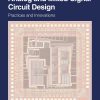
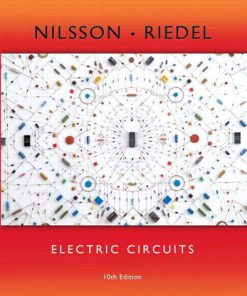
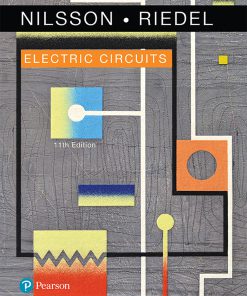
![Electric Circuits [11th Ed] Instructor’s Solution Manual 11th Edition James W. Nilsson](https://textbookfull.com/wp-content/uploads/2024/04/electric-circuits-11th-ed-instructors-solution-manual-7249250-247x296.jpg)
